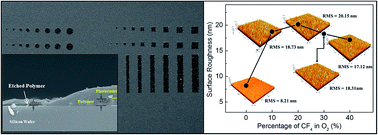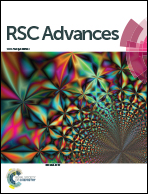Dry etching and residue removal of functional polymer mixed with TiO2 microparticles via inductively coupled CF4/O2 plasma and ultrasonic-treated acetone for humidity sensor application
Abstract
In this study, the etching characteristics of a functional polymer mixed with TiO2 microparticles are investigated using an inductively coupled CF4/O2 plasma (ICP) dry-etching method for humidity sensor application. The etching rate and surface morphology associated with different etching conditions (e.g., ICP power, chamber pressure, and different percentages of CF4 in O2) are investigated, and a maximum etching rate of 795 nm min−1 is obtained. Furthermore, the surface reactions of the polymer with a gas mixture containing CF4/O2 are studied with X-ray photoelectron spectroscopy (XPS), by which the surface binding states and elemental changes are measured during the ICP dry-etching process. We find that the CF4/O2 plasma treatment leads to the presence of TiO2 residue on the surface of the pattern. Therefore, methods for removing the TiO2 residue are tested, and an ultrasonic-treated acetone is chosen to totally remove the residue without damage.


 Please wait while we load your content...
Please wait while we load your content...